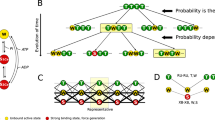Abstract
WHEN vertebrate striated muscle contracts at constant length, the 1,0 reflection decreases in intensity while the 1,1 reflection increases in intensity1,12. These changes have been interpreted as arising from the movement of the cross bridges from the vicinity of the thick filaments in relaxed muscle to the vicinity of the thin filaments in the contracting state, and this movement has been thought to involve both radial and azimuthal components2,3. Lymn4 has claimed that models with cross bridges near the thick filament do not simulate the intensity distribution of the higher order equatorial reflections of relaxed muscle, while models in which the cross bridges are extended to near the radius of the thin filaments do give good simulations. This has led him to contest the interpretation of the intensity changes given above, and to propose instead a model in which these changes are brought about by azimuthal movement alone. In this article we challenge Lymn's interpretation on several grounds.
Similar content being viewed by others
References
Haselgrove, J. C., and Huxley, H. E., J. molec. Biol., 77, 549–568 (1973).
Huxley, H. E., and Brown, W., J. molec. Biol., 30, 383–434 (1967).
Huxley, H. E., J. molec. Biol., 37, 509–520 (1968).
Lymn, R. W., Nature, 258, 770–772 (1975).
Tregear, R. T., and Squire, J. M., J. molec. Biol., 77, 279–290 (1973).
Lowey, S., Slater, H. S., Weeds, A. G., and Baker, H., J. molec. Biol., 42, 1–29 (1969).
Squire, J. M., J. molec. Biol., 90, 153–160 (1974).
Faruqi, A. R., J. Phys., E 8, 633–635 (1975).
Faruqi, A. R., and Leigh, J. S., Acta Crystallogr., A 31, S235 (1975).
Matsubara, I., Yagi, N., and Hashizume, H., Nature, 235, 728–729 (1975).
Parry, D. A. D., and Squire, J. M., J. molec. Biol., 75, 33–55 (1973).
Podolsky, R. J., St. Onge, R., Yu, L., Lymn, R. W., Proc. natn. Acad. Sci. U.S.A., 73, 813–817 (1976).
Author information
Authors and Affiliations
Rights and permissions
About this article
Cite this article
HASELGROVE, J., STEWART, M. & HUXLEY, H. Cross-bridge movement during muscle contraction. Nature 261, 606–608 (1976). https://doi.org/10.1038/261606a0
Received:
Accepted:
Published:
Issue Date:
DOI: https://doi.org/10.1038/261606a0
- Springer Nature Limited
This article is cited by
-
Evaluation of freeze substitution in rabbit skeletal muscle. Comparison of electron microscopy to X-ray diffraction
Journal of Muscle Research and Cell Motility (1995)
-
Changes in thick filament structure during compression of the filament lattice in relaxed frog sartorius muscle
Journal of Muscle Research and Cell Motility (1989)
-
The interpretation of X-ray diffraction patterns from vertebrate striated muscle
Journal of Muscle Research and Cell Motility (1980)
-
Behaviour of myosin projections during the staircase phenomenon of heart muscle
Nature (1978)





